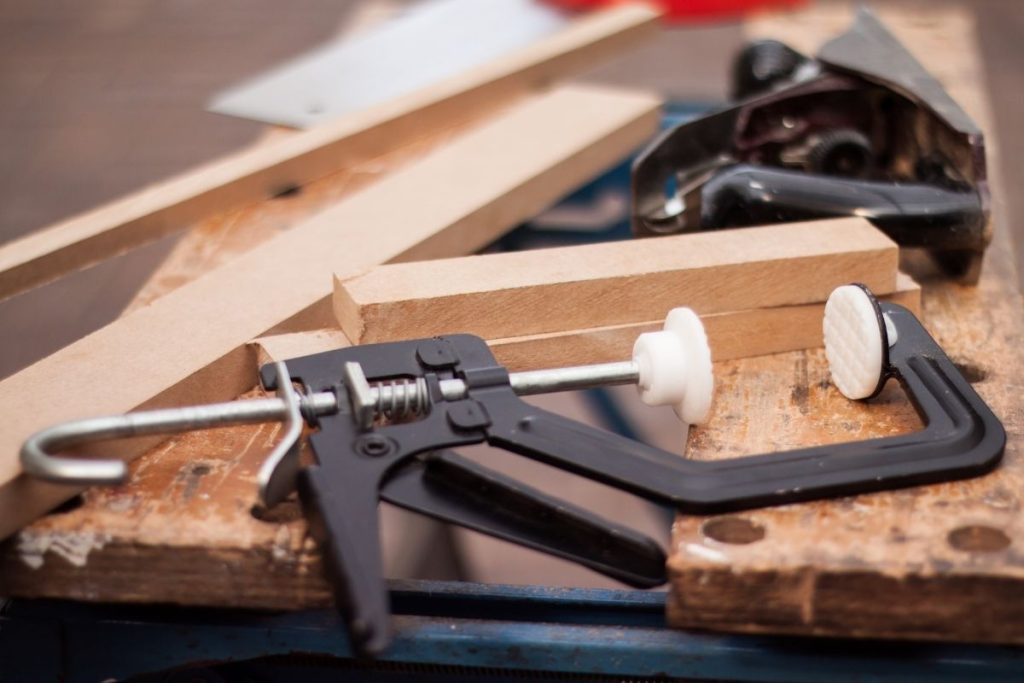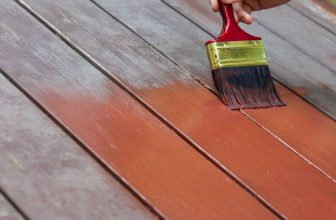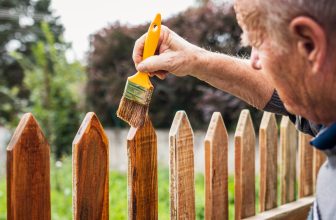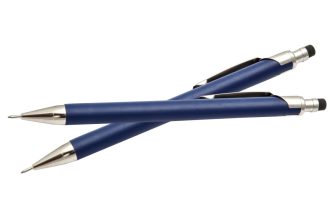Contents
Whether you’re a professional or just someone who enjoys having a side project on the go in their spare time, your tool collection needs at least one high-quality woodworking clamp.
Providing accuracy, precision, and efficiency, almost every woodworking project is much easier with clamps.
Assisting in a wide range of situations such as glue-ups, pilot holes, or brad nailing, you can use them to effortlessly hold things together. For example, you can use a woodworking clamp to keep pieces of wooden furniture in place while you glue them.
And as you should be expecting, high-quality woodworking clamps are also specially designed not to dent or scratch the wood.
While this all sounds great, finding the best woodworking clamps can be tough. There is an overwhelming amount of options on the market, making it hard to distinguish between the best and the worse.
That’s where we come in! To help out, we’ve put a list together looking at the top 5 woodworking clamps on the market right now, looking at what they offer.
If you need help finding the right woodworking clamp, be sure to stick around!

Irwin Quick-Grip Clamps

We’ll kick the list off with one of the best budget-friendly options on the market. If you want a set of four clamps that won’t break your bank but will still perform reliably, the Irwin quick-grip clamps are perfect for you.
Despite their low price tag, these Irwin clamps are versatile, highly functional, and very easy to use. One of their biggest selling points is their one-handed design. This is a useful feature as it makes it much easier for you to maneuver the clamps while working with your other tools and materials.
Each order comes with 4 clamps that vary in size with the smallest being 6 inches and the largest being 12 inches. Between the clamps, you should have exactly what you need to tackle a wide range of projects. However, we found they worked better with smaller projects.
In terms of power and performance, the Irwin quick-grip clamps offer 140 lbs of force. This will be evenly distributed across your project. Good levels of performance and power are in part thanks to the clamp’s solid resin and steel construction.
Built to last, this resin construction prevents any bending or flexing when under pressure.
Pros
- Easy-to-use – These clamps have a one-hand design.
- Applies plenty of force – Irwin’s clamps provide 140 lbs of force.
- Durable – These clamps are made out of heavy-duty resin and steel.
Cons
- Doesn’t offer as much force – Other clamps on the market offer more force.
Bessey 36-Inch Clutch-Style Bar Clamp

Next up, we have the Bessey 36-inch clutch-style bar clamp. This is a good choice for professionals who seek a reliable, versatile clamp that’s super quick and easy to use. It’s also another great option in regards to price.
Providing the user with 1,100 lb of exerted force, this Bessey clamp makes light work of both small and large projects, easily clamping materials together for whatever reason you may have. One neat touch is that this clamp can also be used as a spreader. You’ll find this extremely useful when trying to separate two materials that you can’t by hand.
To ensure the pressure this clamp exerts doesn’t dent or scratch the wood when you apply the clamp, Bessey has conveniently fitted it with padding. This will prevent any damage and also improve durability and comfort when it comes to you using the clamp.
Typically, C-clamps are thought to be pretty basic despite being seen as essential. However, when we tested the clamp, we found that it has a greater width that isn’t limited by the narrowness of other types of C-clamps. This makes the Bessey 36-inch clamp a much more desirable option.
Pros
- Strong – The Bessey clamp exerts 1,100 lbs of force.
- Versatile – Use this clamp for almost any project.
- Comfortable grip – The grip on this clamp is much nicer to hold.
Cons
- Not as robust – Despite being super strong, some reviewers have noted that this clamp isn’t as robust as others on the market.
Also Available at: Homedepot.com
Workpro Spring Clamp Set – 16 Piece

Those of you working on smaller projects that use more delicate, smaller pieces of wood will definitely want to take a look at the Workpro spring clamp set.
Coming with 16 different clamps, the Workpro spring clamp set is lightweight, small, and versatile. By including different sizes of clamp in the set, Workpro has made it much easier for the user to find the clamp that suits their project.
In your set, you can expect to find 6 PC 3-⅜” clamps, 6 PC 4-½” clamps, and 4 PC 6-½” clamps. In terms of clamp force, each clamp then comes with a different jaw size to offer more versatility from project to project. Jaw sizes range from 2-¼” to 1-⅜”.
When it comes to durability, the Workpro clamp set is designed to last. Each clamp is made from heavy-duty springs and screws, also featuring a reinforced nylon design. To guarantee more durability as well as safe clamping, each clamp has a soft padding that protects your project from damage.
When we took a closer look at this clamp set, one thing we loved was each clamp’s ergonomic handle which helps reduce fatigue.
Pros
- Wide range of uses – These clamps can be used in woodworking, other DIY projects, and even photography.
- 16 clamps included – This set gives you 16 clamps for the price of one.
- Sufficient padding – Your projects won’t be damaged by the clamps.
Cons
- Not suitable for bigger projects – These clamps only suit small projects.
Bessey H-Style Pipe Clamp

If you’re in the market for the best H-style clamps, the Bessey H-style pipe clamp could be the one you’re looking for.
An H-style clamp offers impressive versatility in terms of working with a variety of projects. They let you easily secure most of your projects no matter how small or how big they are because the clamps slot into any metal pipe you choose.
With that in mind, Bessey’s H-style clamps are one of the best. Whether you want to clamp shelves or hold a tabletop in place, this pair of H-style clamps will help you out. All you need to do is find a long enough pipe for the job and slot each Bessey H-style clamp-on opposing ends.
The best thing about the Bessey H-style clamp has to be its ability to work with any project. Fitting 0.5 and 0.75-inch pipes, you no longer need multiple clamps. Instead, you just need this one.
When we tested the Bessey H-style clamp, we were most impressed with the clamp’s air circulation. This clamp offers great levels of air circulation. This is incredibly useful when working with painted or glued wood.
Pros
- Super-versatile – This one clamp will do it all.
- Good air circulation – Your glue or paint will dry quicker when using this clamp.
- Simple – Bessey’s H-style pipe clamp is very easy to use.
Cons
- No pipes included – You will have to provide the clamps.
Kreg KHC-Premium Face Clamp

The final woodworking clamp on our list is the KHC-premium face clamp from Kreg Tool. If you have a keen interest in pocket hole joinery, this is a clamp you’ll definitely want to get your hands on.
This quite unique-looking clamp has been cleverly designed to offer its user everything they need for pocket hole joinery.
The clamp’s large, yet flat face helps serve two purposes. One is to hold two pieces of wood in place while you drill and screw the two together. The other is to spread the pressure of the clamp evenly over a much wider area so that no dents are produced during the process.
As if that wasn’t enough, the KHC-premium face clamps super-wide jaw also gives us the opportunity to use the clamp on a much wider range of woods. This is perfect if you work with both small and large pieces of wood on a regular basis.
There are a number of things we liked about this pocket hole joinery clamp. In general, the overall performance and design of the clamp are fantastic. Made from solid alloy steel and equipped with a rubberized handle, we also really appreciate how durable, yet comfortable the tool is to use.
Pros
- Durable – Made from strong alloy steel, Kreg’s face clamp is made to last.
- Perfect for pocket hole joinery – This clamp is specially designed for pocket hole joinery.
- Compatible with other Kreg Tool products – The KHC-premium face clamp works well with other Kreg Tool products.
Cons
- Not versatile – This clamp isn’t as versatile as the others on our list.
Also available at: Kregtool.com
Buyer’s Guide
Now you know what’s on the market, it’s time to start thinking about which woodworking clamp you want to buy. This can be quite difficult as there are lots of key factors to consider, all of which will greatly impact the final decision you need to make.
To help you out, we’ve put together a buyer’s guide. In this buyer’s guide, you will find details regarding the most important things you need to think about. By taking each point we make into consideration, you should be able to make a much better decision and one you don’t later regret.
The Type Of Clamp
Arguably the most important thing you need to consider when looking for a woodworking clamp is the type of clamp you actually need.
There is a wide range of different types of clamps available, all of which are designed with a specific purpose in mind. Therefore, you need to make sure the one you’re purchasing is one that suits your project.
The most popular types of clamps on the market tend to be pipe, C-clamps, face, and right-angle clamps. Clamps that have a C-clamp design are versatile enough for a wider range of projects.
On the other hand clamps like the face clamp can only be used for specific projects such as when joining wood together.
With this in mind, you need to take some time to evaluate what you need a woodworking clamp for and which type of clamp suits your project best.
Clamping Force
It is also important to consider the clamping force a woodworking clamp provides. You need to find a suitable clamp that exerts enough force to get the job done.
A clamp that doesn’t offer enough force won’t hold the wood in place, potentially making the wood move as you work. On the other hand, too much-exerted pressure can damage the wood. Not only could the clamp dent the wood, but it could also split it in two.
To ensure you’re purchasing a clamp that offers the right amount of pressure, you need to take some time to look at each clamp’s force before rushing to a decision. You will find a clamp clamping force in the product description or clamps specifications.
Durability
Similar to the purchasing of any woodworking tool, you need to ensure the tool you’re looking at is going to last. Generally speaking, most woodworking clamps are pretty solid, however, there are some options on the market that just aren’t up to standard. It is these clamps you want to avoid.
Clamps made out of heavy-duty steel and reinforced resin are most likely the last the longest. Alternatively, light-duty resin and anodized aluminum clamps are also good choices. Apart from that, you need to carefully read each product description and reviews to guarantee your chosen clamp is up to the task.
Luckily for you, all of the options we looked at in this article are well-designed and extremely durable. Therefore, we highly recommend going for one of those options first.
Price
It is important to understand that just because a clamp costs more, doesn’t necessarily mean it is the best clamp for your project. It is very easy to see a clamp that costs more and comes from a bigger brand and assume that’s the one you need. This is something you should avoid doing.
There are plenty of more affordable, budget-friendly options on the market that will easily help you complete your project. By simply taking your time to look through each option before evaluating what each one offers, you can make a much better decision and one that could save you a lot of money.
We also recommend setting yourself a budget first. By doing so, you can head straight for the clamps you can afford and avoid any you can’t. This will also prevent you from spending any money you don’t have.
Frequently Asked Questions
How Many Different Types Of Clamps Are There?
You might be surprised to hear that there are actually 30 different types of clamps available on the market. Each type of clamp offers a different way to apply pressure.
To offer a different way of applying pressure, almost every type of clamp has its own unique design. It is this unique design and materials used to produce the clamp that impacts the overall cost of the tool.
The most common types of clamps are C-clamps, face clamps, right-angle clamps, and pipe clamps.
How Many Clamps Should I Own?
Most people that work with wood on a daily basis tend to have their very own collection of clamps that they build up over time. This is a good idea because it ensures that you have a clamp for every eventuality.
If you’re a beginner just starting out on your woodworking journey, it is a good idea to have at least two or three bar clamps and two or three pipe clamps.
How Many Clamps Will I Use?
For most projects, you will probably use at least two clamps. Having said that, the number of clamps and the type of clamps you use will vary from project to project. One thing that impacts the type and number of clamps you use is the type of wood.
Final Thoughts
A reliable woodworking clamp helps you accurately and precisely finish any project. Whether it be keeping two pieces of wood together as you glue them, or simply holding up a piece of painted wood as it dries, a high-quality clamp will make your life much easier.
While it can be hard to find the best clamp due to an oversaturated market, in this article, we have shown you 5 of the best options available right now. The options on our list all offer something different, giving you a better chance to find the clamp that suits your needs and requirements best.
Hopefully, you now have a much better understanding of what’s out there. With help from our buyer’s guide too, you should also know exactly what to look for when making your final decision.
Though we believe all of the clamps on our list are great, it is now time for you to narrow down your options and identify the clamp that suits you best.






